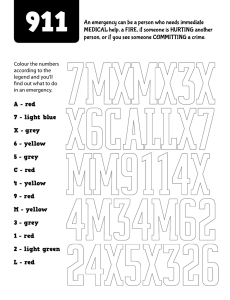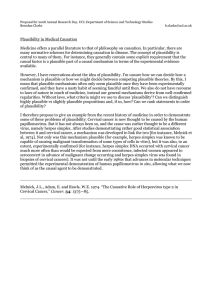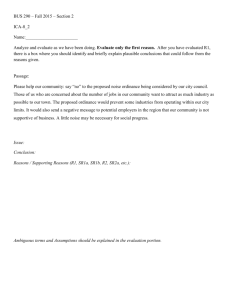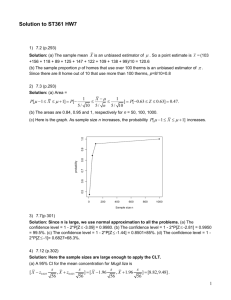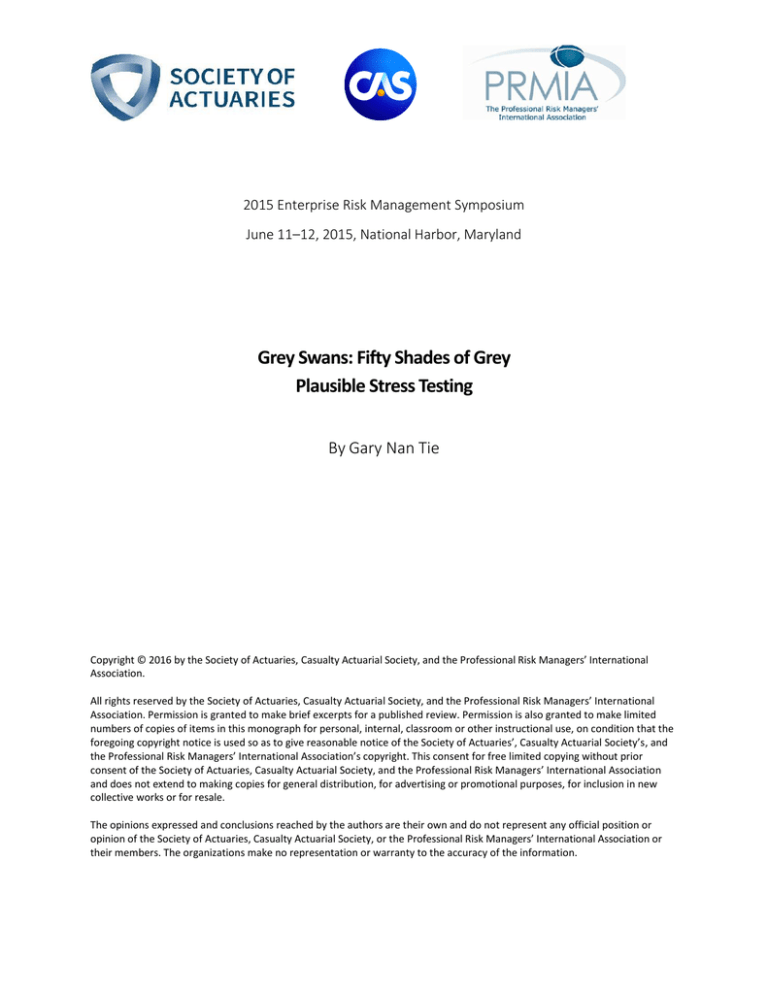
2015 Enterprise Risk Management Symposium
June 11–12, 2015, National Harbor, Maryland
Grey Swans: Fifty Shades of Grey
Plausible Stress Testing
By Gary Nan Tie
Copyright © 2016 by the Society of Actuaries, Casualty Actuarial Society, and the Professional Risk Managers’ International
Association.
All rights reserved by the Society of Actuaries, Casualty Actuarial Society, and the Professional Risk Managers’ International
Association. Permission is granted to make brief excerpts for a published review. Permission is also granted to make limited
numbers of copies of items in this monograph for personal, internal, classroom or other instructional use, on condition that the
foregoing copyright notice is used so as to give reasonable notice of the Society of Actuaries’, Casualty Actuarial Society’s, and
the Professional Risk Managers’ International Association’s copyright. This consent for free limited copying without prior
consent of the Society of Actuaries, Casualty Actuarial Society, and the Professional Risk Managers’ International Association
and does not extend to making copies for general distribution, for advertising or promotional purposes, for inclusion in new
collective works or for resale.
The opinions expressed and conclusions reached by the authors are their own and do not represent any official position or
opinion of the Society of Actuaries, Casualty Actuarial Society, or the Professional Risk Managers’ International Association or
their members. The organizations make no representation or warranty to the accuracy of the information.
Grey Swans: Fifty Shades of Grey
Plausible Stress Testing
Gary Nan Tie
gnt9011@me.com
Mu Risk LLC
Abstract: For the purposes of risk management and stress testing, we characterize a spectrum of plausible extreme events, that we dub Grey Swans, by
introducing a probabilistic method involving the concentration of measure
phenomenon. As a result, stress tests can be triaged according to severity,
probability and, now, information-based plausibility.
This paper is for general informational purposes only.
1
Executive Summary:
Businesses are exposed to multiple risk factors such as insurance perils or
changes in macroeconomic variables like interest rates, credit spreads, inflation, gross domestic product growth, equity prices and exchange rates. For
a non-life insurance company’s underwriting risk factor exposure, consider a
line-of-business list that aggregates similar perils. Suppose that we have a
data set of historical experience or forward-looking multi-period simulations
of this list and that we can estimate the marginal distribution of each risk
factor. Risk management seeks to mitigate deviations from benchmark risk
exposures. Deviations are concentrated around the business-as-usual benchmark in terms of probability. Because of their rarity, extreme deviations
are more difficult to quantify. To address this situation, stress tests posit
extreme risk exposures to quantify their impact, ignoring their likelihood
and dependency assumptions to mitigate model risk. Now, it is tempting
to immediately jump to a ”perfect storm”, that is a list of worst-case risk
exposures. Although possibly informative, its improbable and implausible
nature may not lend itself to feasible mitigative actions. We seek a middle
ground between large deviations and a ”perfect storm”. Indeed, suppose we
start with a list of downside risk exposures, such as our worst actual experience, and then one by one replace an actual risk exposure with the worst-ever
seen, culminating in the ”perfect storm” list. The starting list of downside
risk exposure is certainly plausible because it actually happened, but as we
pile on worst-ever risk exposures, the less plausible the list of risk exposures
becomes. In terms of plausibility, we introduce a spectrum of extreme events
that we call Grey Swans for the purposes of stress testing. This enables management to focus on mitigating the most plausible and most probable lists
of extreme risk exposures. The new dimension we are introducing, beyond
severity and probability, is the notion of plausibility, the gist of which is how
different in terms of pattern is a proposed stress test list from known downside
benchmark lists of risk exposures. Like the notion of probability, plausibility
can be made mathematically rigorous. We use information theory. Between
a downside benchmark and black swan lists of risk-factor exposures, there
is a spectrum of Grey Swans, with different degrees of plausibility, for risk
managers to consider when stress testing. In conclusion, stress tests can be
triaged by severity, probability and, now, plausibility.
2
Introduction:
Suppose we observe or can simulate a large set A of random n-vectors and
that we can estimate the marginal distributions. An example could be insurance line-of-business losses, including investment losses. For a suitable
notion of (probability) measure ν and (convex) distance that is information
based, we will describe a parameterized family of enlargements {At }t≥0 of A
such that s > t implies As ⊃ At ⊃ A and ν(1 − At ) → 0 as t → ∞. Think
of At as a set of plausible yet unrealized n-vectors close/similar to A and
complement Act as possible but unlikely less plausible events different from
A. Indeed, the smaller the parameter t, the closer to A, the more plausible
the enlargement At of A. Consider a feature or statistic of A, such as the
n-vector y ∈ A whose aggregate loss is the greatest among those in A. For
each ∑
enlargement∑At , we will find x ∈ At similar in pattern to y ∈ A such
n
that ni=1 xi ≥
i=1 yi , i.e., a plausible n-vector x close to worst experienced y in A whose aggregate loss is even larger. So A is a set of known
losses, enlargement At is a set of unrealized plausible losses, complement Act
are the possible but unlikely implausible events containing black swans, and
x ∈ At (similar in pattern to y ∈ A) is a plausible potential loss greater than
anything in known A, which we call a Grey Swan. Moreover, we can find
different shades of grey by varying the degree of plausibility t.
Application of Talagrand’s concentration of measure inequality:
By Sklar’s representation theorem, the distribution function FX of a random
n-vector X can be represented as a copula:
FX (x) = C(F1 (x1 ), F2 (x2 ), · · · , Fn (xn )),
x ∈ Rn .
The probability density function of X with copula C and marginal distribution functions F1 , F2 , · · · , Fn admits the representation:
fX (x) = (
n
∏
fi (xi ))c(F1 (x1 ), · · · , Fn (xn )),
x ∈ Rn ,
i=1
n
where copula density c(u) = ∂u1∂···∂un C(u), u ∈ [0, 1]n , i.e., fX is obtained by
reweighting the probability density function corresponding to independence
using the copula density c.
3
Let A be a large sample of n-vectors from X. View A as a subset of the
product space of marginals of X. In this probability space, we will enlarge
A in each dimension and show that the degree of plausibility depends on
information content. Before we recall Talagrand’s concentration inequality,
we will need to introduce some notation:
For n-vectors x and y, the Hamming distance, dH (x, y), is the number of
indices i such that xi ̸= yi .
△
dH (x, A) = inf{dH (x, y) | y ∈ A}.
Let α = (α1 , α2 , · · · , αn ) ≥ 0,
△
dα (x, y) =
∑
αi ,
i:xi ̸=yi
(so dH (x, y) = d(1,··· ,1) (x, y)),
△
dα (x, A) = inf{dα (x, y) | y ∈ A}.
Talagrand’s convex distance:
△
dT (x, A) = sup {dα (x, A) | ∥α∥2 = 1} .
Note that dT (x, A) ≥ d( √1
n
,··· , √1n ) (x, A)
=
√1 dH (x, A).
n
An equivalent geometric definition of Talgrand’s convex distance is as follows:
Let P (x, y) denote the set of zero-one n-vectors, which are one on coordinates
i for which xi ̸= yi .
△
P (x, A) = ∪y∈A P (x, y).
Then dT (x, A) = min{∥z∥2 | z ∈ conv P (x, A)}, where convS
√ denotes the
n
convex hull of a set S ⊂ R . Hence dT (x, A) ≤ dH (x, A) ≤ ndT (x, A).
Let t be a positive real number and Ω be an n-dimensional product space.
Let A ⊂ Ω and let At = {x ∈ Ω | dT (x, A) ≤ t}. Note that s > t > 0 ⇒
As ⊃ At ⊃ A.
Theorem (Talagrand’s concentration inequality):
P r[A](1 − P r[At ]) ≤ e−t
4
2 /4
In particular, if P r[A] ≥ 12 (or any fixed constant) and t is “large” then all
but a very small proportion of Ω is within “distance” t of A.
We now use Talagrand’s concentration inequality to define Grey Swans, giving two examples.
Insurance example:
For ease of exposition, we continue in the insurance context.
Let A
∑i n= {z ∈ Ωi | ∃ a ∈ A with ai = z}. Choose y ∈ A such that aggregate
loss i=1 yi is maximized. Rank the component losses y[1] ≤ y[2] ≤ · · · ≤ y[n] .
Let mi = max{z ∈ A[i] } and let x = (m1 , m2 , · · · , mt , y[t+1] , · · · , y[n] ) ∈ Ω.
Then dH (x, A) ≤ t, so for 1 ≤ t ≤ n,
x ∈ At and
n
∑
i=1
xi ≥
n
∑
yi .
i=1
The larger the t, the more extreme and less plausible the x.
x is a plausible potential extreme n-vector similar in pattern to known y ∈ A
whose aggregate loss is greater than anything experienced in the sample A,
which we call a Grey Swan. For example, if n = 6, degree of plausibility t = 4
and P r[A] ≥ 21 then P r[A4 ] ≥ 0.9634 and x = (m1 , m2 , m3 , m4 , y5 , y6 ) is a
Grey Swan, extreme but plausible. On the other hand, m = (m1 , m2 · · · , m6 )
is an implausible perfect storm stress test outside of A4 . So, in this example,
the random sample A generated by X occupies more than 50 percent of the
product space of marginals and the plausible enlargement A4 of A more than
96.34 percent. The copula density distorts the independent product space pdf
to induce the actual dependence structure of the pdf of X. Nonetheless, A is a
subset of A4 and Grey Swan x ∈ A4 has aggregate loss greater than anything
experienced in A yet is similar to y ∈ A. Moreover, we have a spectrum of less
extreme, more plausible Grey Swans corresponding to degrees of plausibility
1 ≤ t ≤ 4. Fifty shades of grey!
Banking example:
In the context of banking, let X be a random vector of macroeconomic variables, for example, X = (10-year Treasury yield, S&P 500 index, VIX, GDP,
consumer price index, dollar/euro exchange rate). We want to design plausible stress tests of portfolio value V (x). Order each component macrovariable
5
so that V is componentwise monotone. The sample A from X is a large
collection of economic scenarios. Suppose we can estimate each marginal
distribution well so that P r[A] ≥ 12 . Choose y ∈ A so that V (y) is say the
30th percentile, i.e., y is a stress scenario. Let x ̸∈ A be a modified y where we
have replaced three components with “lower” values so that V (x) ≤ V (y).
The choice of which components and values will depend on our utility for
their severity and probability. This x ∈ A3 , similar in pattern to y ∈ A, is a
plausible (triple whammy) stress scenario, which we call a Grey Swan. Talagrand’s inequality implies P r[A3 ] ≥ 78.92 percent. So this enlargement of A
captures a majority of the possible combinations of the six macrovariables.
Thus a scenario outside of A3 , like a perfect storm, would not be consistent
with the majority of economic patterns similar to those in A. In this sense,
it is plausible to have up to three extreme events occurring at once but not
more. So in designing stress tests, not only is there severity and probability
of events to consider, there is also the plausibility of their pattern. Note
that there is flexibility in choosing the feature/statistic V (y) and that this
approach to plausible stress testing is a form of pattern recognition.
In practice, our application of Talagrand’s inequality to strings of extreme
events, has a ”curse of dimensionality.” To see this, recall that if P r[A] ≥ 12
2
then 1 − P r[At ] ≤ 2e−t /4 . Now (0.8)3 = 0.512, (0.9)6 = 0.531 and (0.95)13 =
0.513. Note too that
(
)n
n
∏
p1 + p2 + · · · + pn
pi ≤
, 0 < pi < 1.
n
i=1
So the higher the dimension n of the product space, the higher the average
probability mass of A across the marginals for the bound above to apply.
The issue is how well can one estimate P r[A] in higher dimensions. The
less/more we know about A, the greater/fewer the number of Grey Swans to
be entertained in stress tests.
Stress test results, while informative, often do not lend themselves to feasible
mitigative actions because of their improbable worst-case nature. In the
spectrum of scenarios between “business as usual” and a “perfect storm”
we have introduced degrees of plausibility. So stress tests can be triaged by
severity, probability and, now, information-based plausibility. This enables
management to focus on mitigating the most plausible and most probable
lists of extreme events.
6
References:
Talagrand, Michel 1995. ”Concentration of measure and isoperimetric inequalities in product spaces.” Publications Mathématiques de l’Institut des
Hautes Études Scientifique. 81(1): 73-205.
7

